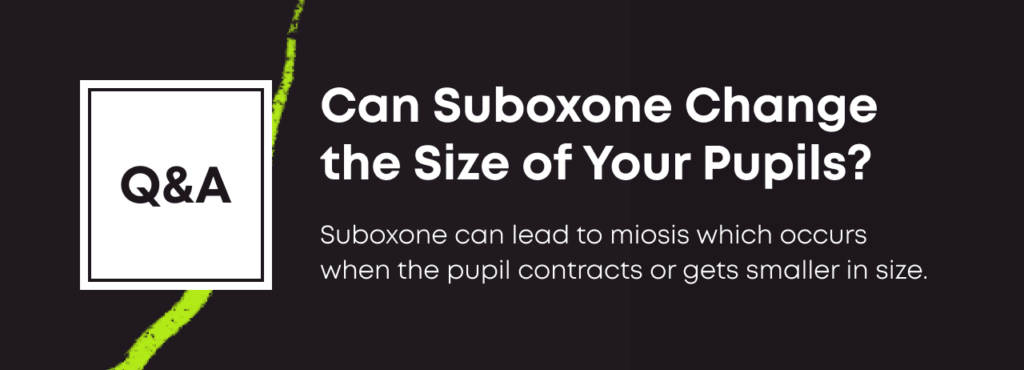Suboxone may make your pupils contract, but this isn’t normally a concern. It won’t have a significant effect on most people’s vision, especially if they are taking the drug only as prescribed and no more serious symptoms also occur.
This also isn’t generally a permanent effect. Your eyes will act as normal if you stop taking the drug.

How Does Suboxone Impact Pupil Size?
While not powerful like the opioids typically associated with misuse, Suboxone contains a partial opioid agonist, buprenorphine. This means it can change the size of one’s pupils.
The reason pupil size changes normally occur has to do with the balance between the body’s sympathetic and parasympathetic systems.[1] However, opioids (and some other drugs) can also cause changes to pupil size and how pupils react to stimuli.
Suboxone has the potential to cause miosis, which is the medical term for when a pupil contracts (gets smaller) more than normal. Normally, this isn’t a major concern, especially if the drug is only used as prescribed.
Pupils typically get larger in low-light environments, helping the eye to take in more light, and smaller when in bright environments, helping the eye to avoid taking in too much light, which can be painful or distracting. If the eye is artificially contracted, this isn’t usually going to cause any serious problems, although it could theoretically reduce one’s low-light vision (although this isn’t usually a reported symptom of Suboxone use).
Other Signs & Side Effects of Suboxone Use
While considered to have low misuse and addiction potential, Suboxone is still an opioid.[2] It can have certain side effects beyond contracting one’s pupils that, while they don’t negate its potential to help in addiction recovery, are still worth understanding.
Suboxone can cause physical dependence, which means a person may experience mild withdrawal if they suddenly stop taking it. However, it should be noted that Suboxone treatments are generally to treat addiction to more powerful and more damaging opioids. Many people who are prescribed Suboxone are already dependent on opioids that would cause more severe withdrawal if they suddenly stopped them without taking any medication for opioid use disorder (mOUD).
Suboxone can cause some respiratory depression, although this usually won’t be dangerous if the drug is taken on its own. It can, however, be dangerous for people with certain health conditions that already affect their breathing or who are mixing Suboxone use with other substances that can depress breathing, such as alcohol.
Some of the more common unwanted side effects of Suboxone use include some issues with sleeping and coordination. While not usually a major concern, you should still talk to a doctor about these symptoms if they seem severe or are significantly impacting your quality of life.
Suboxone can tax the liver, although not generally so severely that it is a problem when taken as prescribed by a generally healthy individual. Signs of serious liver problems that warrant immediately talking to a doctor include the following:
- Yellowing of your skin or the whites of your eyes
- Dark urine
- Loss of appetite
- Nausea
- Pain or aches in the right side of the stomach
- Light-colored stool
Sources
- Role of sympathetic and parasympathetic systems in reflex dilatation of the pupil: Pupillographic studies. Archives of Neurology & Psychiatry. https://jamanetwork.com/journals/archneurpsyc/article-abstract/651026. 1950. Accessed March 2023
- Patient Information for Suboxone. Indivior UK Limited. https://www.suboxone.com/. Accessed February 2023.

Reviewed By Peter Manza, PhD
Peter Manza, PhD received his BA in Psychology and Biology from the University of Rochester and his PhD in Integrative Neuroscience at Stony Brook University. He is currently working as a research scientist in Washington, DC. His research focuses on the role ... Read More
Download Our Free Program Guide
Learn about our program, its effectiveness and what to expect
Related Content
Imagine what’s possible on the other side of opioid use disorder.
Our science-backed approach boasts 95% of patients reporting no withdrawal symptoms at 7 days. We can help you achieve easier days and a happier future.
